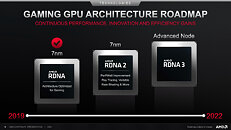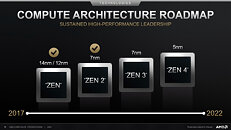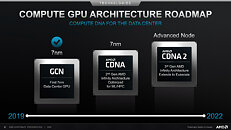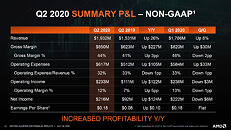Tuesday, July 28th 2020

AMD Confirms "Zen 4" on 5nm, Other Interesting Tidbits from Q2-2020 Earnings Call
AMD late Tuesday released its Q2-2020 financial results, which saw the company rake in revenue of $1.93 billion for the quarter, and clock a 26 percent YoY revenue growth. In both its corporate presentation targeted at the financial analysts, and its post-results conference call, AMD revealed a handful interesting bits looking into the near future. Much of the focus of AMD's presentation was in reassuring investors that [unlike Intel] it is promising a stable and predictable roadmap, that nothing has changed on its roadmap, and that it intends to execute everything on time. "Over the past couple of quarters what we've seen is that they see our performance/capability. You can count on us for a consistent roadmap. Milan point important for us, will ensure it ships later this year. Already started engaging people on Zen4/5nm. We feel customers are very open. We feel well positioned," said president and CEO Dr Lisa Su.
For starters, there was yet another confirmation from the CEO that the company will launch the "Zen 3" CPU microarchitecture across both the consumer and data-center segments before year-end, which means both Ryzen and EPYC "Milan" products based on "Zen 3." Also confirmed was the introduction of the RDNA2 graphics architecture across consumer graphics segments, and the debut of the CDNA scalar compute architecture. The company started shipping semi-custom SoCs to both Microsoft and Sony, so they could manufacture their next-generation Xbox Series X and PlayStation 5 game consoles in volumes for the Holiday shopping season. Semi-custom shipments could contribute big to the company's Q3-2020 earnings. CDNA won't play a big role in 2020 for AMD, but there will be more opportunities for the datacenter GPU lineup in 2021, according to the company. CDNA2 debuts next year.CEO Dr Lisa Su also reiterated that the future-gen "Zen 3" microarchitecture is "in the lab and looking good," and that it will be built on the 5 nm silicon fabrication process. The AMD corporate presentation confirms that "Genoa" will be the codename of the EPYC product based on "Zen 4." The slide suggests a 2021 rollout of "Genoa." The same presentation also points to "Zen 3" based Ryzen products debuting within 2020, and a 2021 debut of the RDNA3 graphics architecture on an "Advanced Node." Consumer graphics continues to be a weak spot for AMD, with revenues on the decline. AMD is betting on RDNA2 and a "full refresh" of the product stack to turn its fortunes around. While semi-custom shipments will drive Q3 revenues, Q4 is expected to be propelled largely by "Zen 3" and RDNA2.
AMD isn't celebrating Intel's fumbles with foundry nodes just yet. As a fabless chip-maker, the company is still at the mercy of TSMC for growth in volumes. Su commented that 7 nm supply situation is "still tight" for AMD. She stated that the company is working with TSMC to ensure it can satisfy customer demand.
AMD appears unfazed by Intel "Tiger Lake." Ryzen 4000 series processors based on the "Renoir" silicon will continue to drive revenues for AMD in the mobile segment, in 2H-2020. In the call, an analyst with JP Morgan and Chase shared findings of the firm's internal survey of CIOs across the industry. According to the survey, CIOs are increasingly receptive to deploying AMD EPYC processors. An analyst also asked AMD if it sees a threat with Arm in the server space, especially in the light of Apple dumping x86. Dr Su said she's quite confident that the PC and server markets remain predominantly x86, and that it's on chipmakers to ensure the x86 remains competitive.
For starters, there was yet another confirmation from the CEO that the company will launch the "Zen 3" CPU microarchitecture across both the consumer and data-center segments before year-end, which means both Ryzen and EPYC "Milan" products based on "Zen 3." Also confirmed was the introduction of the RDNA2 graphics architecture across consumer graphics segments, and the debut of the CDNA scalar compute architecture. The company started shipping semi-custom SoCs to both Microsoft and Sony, so they could manufacture their next-generation Xbox Series X and PlayStation 5 game consoles in volumes for the Holiday shopping season. Semi-custom shipments could contribute big to the company's Q3-2020 earnings. CDNA won't play a big role in 2020 for AMD, but there will be more opportunities for the datacenter GPU lineup in 2021, according to the company. CDNA2 debuts next year.CEO Dr Lisa Su also reiterated that the future-gen "Zen 3" microarchitecture is "in the lab and looking good," and that it will be built on the 5 nm silicon fabrication process. The AMD corporate presentation confirms that "Genoa" will be the codename of the EPYC product based on "Zen 4." The slide suggests a 2021 rollout of "Genoa." The same presentation also points to "Zen 3" based Ryzen products debuting within 2020, and a 2021 debut of the RDNA3 graphics architecture on an "Advanced Node." Consumer graphics continues to be a weak spot for AMD, with revenues on the decline. AMD is betting on RDNA2 and a "full refresh" of the product stack to turn its fortunes around. While semi-custom shipments will drive Q3 revenues, Q4 is expected to be propelled largely by "Zen 3" and RDNA2.
AMD isn't celebrating Intel's fumbles with foundry nodes just yet. As a fabless chip-maker, the company is still at the mercy of TSMC for growth in volumes. Su commented that 7 nm supply situation is "still tight" for AMD. She stated that the company is working with TSMC to ensure it can satisfy customer demand.
AMD appears unfazed by Intel "Tiger Lake." Ryzen 4000 series processors based on the "Renoir" silicon will continue to drive revenues for AMD in the mobile segment, in 2H-2020. In the call, an analyst with JP Morgan and Chase shared findings of the firm's internal survey of CIOs across the industry. According to the survey, CIOs are increasingly receptive to deploying AMD EPYC processors. An analyst also asked AMD if it sees a threat with Arm in the server space, especially in the light of Apple dumping x86. Dr Su said she's quite confident that the PC and server markets remain predominantly x86, and that it's on chipmakers to ensure the x86 remains competitive.




13 Comments on AMD Confirms "Zen 4" on 5nm, Other Interesting Tidbits from Q2-2020 Earnings Call
5nm
ARM vs AMD
cpu cores and most important TOTAL power consumption
That's all I wanted to hear rest was expected. People were frothing over how ARM is now going to shred everything and BS just because Apple whose marketshare and it's own profit cut for Mac is at less than 10% is going full ARM (be mindful Apple said it will take 2 full years for transition, and by that no one knows how Intel and AMD will innovate plus that is for Consumer only with their BGA disposable Macs) with closed BS walled garden and how useless SPEC scored of Anandtech are being heralded as something out of this world in reality barely beat an Android flagship in same application performance. x86 is very robust and has superb backwards compat thanks to Windows and Linux and more cusotmizable, gives user the freedom to control the filesystem and HW DIY.
With AMD's Zen 4 going 5nm cannot wait to see how they will be very efficient and powerful, wonder if it's MCM or Monolithic, 3300X showed how monolithic Ryzen is very powerful and Zen 3 cores are going to be unified CCDs more of a monolithic, perhaps that MCM was just a short term for Zen to be efficient for TSMC and GloFo WSA and cheaper to make. Maybe GPUs will utilize it more.
That statement actually puts the onus on x86 makers to ensure that the top tier of PC, enterprise arena remains their stronghold which is to say that any slipup from even one of them will lead ARM straight through the gate. Again this BS that x86's superior because of <reasons> needs to stop. ARM is in a better position to rival & probably overtake x86 in the long run as there are more players over there while the single biggest reason why this hasn't happened as quickly IMO is inertia, the entire (software) ecosystem is built around x86 & when that starts being ported over or built from scratch for ARM then AMD & especially Intel will be in a whole heap of trouble.
Ampere's Altera 128C 250W is still yet to show and they again have that Cloudflare as customer LOL, cannot wait to see how Milan is going to decimate that and how Cloudflare is again going to drop them, people forget how IBM Power9 and upcoming Power10 are still there and that's not even competing with the 99-98% of the DC market which is owned by 94% Intel 4-5% AMD. Wonder who are those "more" players we have in the industry building ARM server processors fighting for that 1% Marvell I guess, ThunderX2 perhaps how great it was vs ThunderX but loses to the Xeon SKL & EPYC. Soon that ThunderX3 will be coming on 7nm and going to smash EPYC7742 I guess. Ah Kunpeng 920 7nm by Huawei it is along with Hygon built at SMIC.
Even Linus Torvalds thinks ARM cannot take over servers at all. Apple's Rosetta2 ARM-x86 translation layer, everyone will see how their new processors are going to be, and the aspect of making the software from scratch, Apple pays millions to Adobe and other Software giants to make the applications as First Party. That's why Macs have higher battery with them along with i Devices and any third party software results in drop of that.
Maybe I should come and see these ARM posts after 10 years probably along with the AT forums where ARM Apple processors are heralded as Alien technology and taking over the world by getting the useless x86 technology by the superior ARM masterrace.
This is about Apple vs x86. That is quite different.
When you've got an A14 on an iPad Pro leaked bench that shows it's 25% faster than the fastest x86 on single core, it makes one think a moment. And that occurs right after a two year old A12 running Geekbench on Windows in x86 emulation using Apple's new dev kitgets about 85-90% of x86 single core performance. Keep in mind, neither of these were optimized for desktop.
What're the odds of this being an inflection point? Two months ago I would've said 1%.
After seeing more information, I'm thinking this might be close to 50/50 now. If apple pops out with 50%+ higher performance and 75% higher IPC like those numbers suggest, every professional content creator on the planet who intends to be competitive will instantly jump ship. It will take time for the rest, but those kinds of performance advantages will do it.
I mean look at the A14 with double the single core performance of Qualcomms latest and best. Don't underestimate that.
Apple clearly was doing it for 3 reasons One - more R&D spent overall into the A series, ROI % increase is what they care. Two - Intel 10nm woes and the BGA Macbooks having cooling issues with cost-cut VRM components, Third - Mac sales only are very less volume, their whole OS marketshare is less than 10% and the Mac sales for revenue and profit cut for Apple is also under 10%, Services earn more at 17%, so having to rewrite their SW for Alderlake stopgap Big little trash from SW and that HW issues fixing wasn't viable, logical path would be better to move everything to A series as Mac is also now more of an iOS rather a *nix alternative, they already axed 32bit apps, with this soon x86 will be EOLed as well once that Adobe and other big software companies start to build tailored apps like they always do because Apple pays them. And their consumers do not care anything about what's in them or how they are getting ripped off, they only care about that "experience" and with this, Apple controls every single stack vertically, more stronger in terms of what they can do and no need to pay Intel at all.
"2019, the company's iPhone business accounted for approximately 54.7% of total sales. Apple’s growing services segment made up approximately 17.7% of revenue, ahead of the Mac, which generated 9.8% of total revenue. The wearables, home and accessories segment comprised 9.4% of sales and the iPad accounted for 8.1%"
As for gaming which is a bigger proponent for changes only PC gaming market is 24% (x86), Console is 30% (x86) and mobiles are 46% (just because of sheer volume of devices, AAA is not going to happen there at all), with DX12U spearheading next gen console tech and Zen 2 along with Stadia, GeForce Now, XCloud all use x86 only PSN maybe uses Power, I don't see any scope for ARM here. Plus Apple is not competing in the x86 race, Ampere, Marvell are the ones not Apple, Apple doesn't care about Server / DC / HPC markets they do not have any consumers there, they only care about their consumer market for iPhone, Sercvices etc.
To be completely honest, they both have their advantages. You don't see x86 having accelerators tacked on (typically,) because the things that need to go fast per clock cycle have already been optimized for the architecture and that it's vastly different workloads that find their way out of the CPU (like with HPC solutions.) ARM on the other hand is adjusted to fit the needs of the device. This means that you could have all kinds of possible configurations of ARM CPUs, where some support some things, but not others.
Seriously, think about it. The difference between a modern Raspberry Pi and an iPhone has very little to do with ARM and everything to do with what got tacked on to it.
With that said, ARM is only as good as its implementation and X86 is far less fragmented in terms of chip capabilities than ARM. Things like that makes it very hard to write performant software that runs on all ARM chips. So your statement is correct, if you want to rally around a company like Apple who will give you tools to get the work done, but good luck applying those same optimizations to another company that produces ARM chips.
So tl;dr: Yes, ARM-based chips can be fast, but that's not ARM, that's what gets tacked on to ARM.